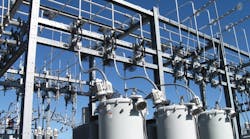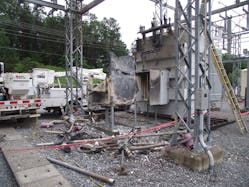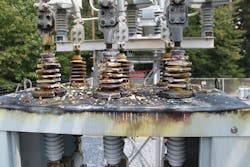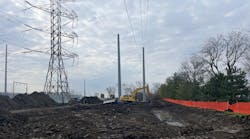Unwanted animal intrusions can damage equipment and disrupt power inside a substation. Utilities may experience the consequences of animal contact immediately, or not until months or even years later. For example, transformers could prematurely reach the end of their life due to the high fault current experienced during an in-the-fence fault event, or animal contact can impact power quality by creating capacitor trip outs or voltage sags.
When equipment fails, utilities may not make the connection between the outage and a previous animal contact within the substation. Here are nine ways to prevent animal contact within substations before they can evolve into costly problems.
1. Pinpoint the Cause of the Contact
Utilities must first identify the culprit species before determining which solution is best at a given location. Animals can enter a substation in a variety of different ways, so it’s critical to discover how they got into a substation before deciding on the most effective mitigation effort.
For example, at Duke Energy, squirrels tend to be the most frequent cause of distribution-level substation faults. Squirrels are of the order Rodentia, which literally means “gnawing animal.” As such, care must be taken to not offer squirrels something to chew.
However, if birds are a cause of contacts inside a substation and space is not available, the only option is to cover up bushings, arrestors and bus insulators with plastic. Utilities can use fences to help stations with non-flying animal problems. Accurate outage data is helpful when identifying the offenders.
2. Discover Their Motivation
Smaller birds are often drawn to partially sheltered places to nest as well as vantage points to watch for predators. These spaces can be open pipe ends on the structure, underneath insulators at disconnects and even inside plastic animal protection covers. Larger birds often perch on top of substation equipment to look for prey.
Along with birds, other animals such as mice can sneak into substations. Mice are often initially drawn to the grass seed that utilities sow around the station to control erosion. These critters are drawn to places with concealing routes to protect them from predators and, as rodents, they like having a supply of things to gnaw.
Snakes are cold blooded, so they often slither into substations to find a warm spot to curl up in the sun. Like raccoons, they find their way into substations to dine on mice, small birds and eggs.
Squirrels mostly like to eat nuts and seed, and as such, they’re always in search of a morsel attached to a tree. Sometimes they can’t remember where they stored their stash, and they wind up inside of a substation.
Unfortunately, attempts to predict which stations will attract what kind of animals, based on the environment, are often proven wrong. Some substations in wooded areas have never experienced animal events, while others that are surrounded by parking lots have been inundated by squirrels.
3. Obtain Proper Clearance
Whether a utility is facing issues with squirrels or birds, it’s important to give these animals the benefit of space and insulation. Depending on the height, width or stretch of a particular animal, it may be small enough to not have a conflict with the designed insulating space.
A minimum design space at 12 kV is 6 inches, 24 kV is 8 inches and 35 kV is 11 inches. Many bird species and squirrels (if they keep their tails down) can navigate fairly freely on a 24-kV bus, but they do not fare as well at 12 kV. To avoid this, the general industry recommendation is to allow 24 inches, roughly the length of a large squirrel. Utilities can obtain this insulating space by covering the reachable energized elements with insulation or providing greater space.
4. Learn About Solutions
When utilities try to find the best approach for solving their wildlife problems, they’ll discover that there are many different products available on the market. They are generally not completely passive solutions, but the more passive they are, the more effective they seem to be.
Utilities have tried to guard against animal intrusions with noise makers in the past, but they often have limited success. Birds learn to ignore ultrasonic bird deterrents, and they’re only scared off temporarily by devices that screech like a bird of prey. Cannons can create a very loud boom, but unless they’re used in a remote area, they’re likely to meet resistance. Air horns are not favored in residential areas either.
Duke Energy has tried installing decoys like owls and snakes, but they often don’t prevent the animal events from occurring within substations for long. Some of these decoys appear to move in the breeze. Also, huge inflatable scarecrow-type men can be triggered by motion. When it detects movement, a fan causes the deterrent to leap up, scaring the intruder.
5. Consider Cover-ups
During Duke Energy’s smart grid initiative in Ohio beginning in 2010, the renovated distribution substations were concurrently covered up. Many of the substations featured tight spacing, so the utility used a lot of tape on the cover-ups, which have since experienced some unraveling.
The UV resistance and the design of these cover-ups is improving, however, time will tell if they actually can extend the life expectancy. The material costs may begin at about $15,000 for a small one-bank station to just under $60,000 for a large distribution station.
6. Install Fencing
Another option for utilities is installing an electric fence. Duke Energy has installed the modified cattle fence wires inches above the ground around the outside of the fence. The problem with these fences, however, is that they often fall into disrepair, become grounded by the grass and present safety questions. Also, spikes and sharp wires on and around exterior fences haven’t been able to ultimately stop raccoons and other animals from substation entry.
Another problem with fences is that utilities often forget to block animal access via adjacent poles, structures and conductors exiting the substation.
To provide the greatest space between the animal and energized elements, utilities may install animal-deterrent fencing in place of the standard perimeter fence, which isn’t electrified. Otherwise, interior fences, which may or may not be electrified, are also available. For the past 10 years, Duke Energy has been using all three types of fences, which have proven to be the most effective over the long term for the stations with the non-flying animals.
An interior electrified fence, such as the TransGard installed by Duke Energy, has alternately energized and grounded mesh panels with a PVC plastic frame about 3 ft high. The panels are easily removed and reinstalled for any work that needs to be done requiring equipment access. There are walk-through sections for routine inspections, and gravel is piled up against the outside of the panels to deter animals from digging underneath it. Human visitors failing to re-energize the fences is still considered a failure mode.
Inattention to restore the tight joining of the panels or not scraping the gravel back up to seal the gaps at the bottom will allow snakes easy access. Interior fences alleviate the need for additional vegetation maintenance and come at a lower initial cost than exterior placed fences.
Duke Energy has also installed several non-electrified interior fences from Vanquish. These fences are 5-ft-high expanded metal panels with Vanquish’s animal-resistant designed top. The panels may be heavier to remove and install, but they can be installed in a straight line, which is advantageous because of the premium for square footage within substations.
The human egress doors are similar to actual exterior doors in a building, including panic bars for quick exit. The cost competes with the electrified competitor. As with the other interior fence protection, care must be taken to monitor its integrity and restore the gravel after panel moves. The nonelectrified fence does not suffer from failed electrical chargers or forgetting to turn the fence on after exiting or handling.
The perimeter animal-deterrent fence is usually the most costly for the short run, but it has proven to be the most effective for Duke Energy so far. The utility has perimeter Vanquish fences, and having installed the first generation of this style 10 years ago, the durability has proven to be on pace with the standard 2-inch chain-link fences, which are not considered for replacement for 40 years.
As with all technology, continual improvements are being discovered. The utility is now installing gates, where possible, on rollers, and ensuring that the vegetation is cleared from the sides and from above these fences.
7. Factor in Longevity
Because of the extreme vendor differences in the materials used and approaches to deterring critters, the lifespan of the different animal-deterrent products vary significantly. For example, noise makers tend to be effective for about a month before immunity of the sound or neighbors start to complain. And the direct cover-ups can last 10 years, but bushing covers can fall to the ground one year after commissioning.
The electrified interior fence is assumed to last about 15 years, but at Duke Energy, the often-moved fences last about 10 years because of damage caused during handling and UV-ray damage decreasing ductility.
The non-electric interior fence, though only having been in use a few years, is expected to last 30 years. The reason it may not last as long as Duke’s standard galvanized fence, however, is because of handling. It is not in actual contact with the soil, but rather is contacting gravel, so it may fair better.
The non-electric perimeter fence is made of essentially the same materials and in the same location as Duke’s old fences, which could last for 40 years.
8. Measure the Solution’s Success
The percent of improvement may be calculated after some years of having the deterrent in place. Multiplying the “station years” times the animal events before the deterrent install and likewise for the “station years” after the deterrent, to get the annual rate of failures. Apply this formula:
In determining the success of a method, it’s advisable to use only the targeted failure types. Flying animal intruders were not included as a target failure mode for fences, for instance. The animal events that may have been rooted in a human error (such as not closing the gate) are valid method failures because they are inherent.
Duke Energy has used a standard calculation to incorporate the above information with the history and load of the station. The value for a customer outage saved determines a dollar value for a solution.
While the utility has tried different solutions, there may be other methods that it hasn’t tried, and in the future, there likely will be more methods and refinements made available.
9. Train Your Staff
Remember that humans can undermine nearly every animal mitigation effort. As such, everyone entering the substation must be aware of the potential animal problem and maintain the integrity of the deterrent program. Utilities must train their employees to keep an eye out for electrified fencing that has been left de-energized. Removed and re-installed panel fences may be replaced without securing the gravel around the base, and fencing gates may be left open and vulnerable to animal entry during periods of substation work.
Another common challenge surrounds the rubber and plastic covering of bushings, arrestors and bus insulators. Electric utilities often perform a painstakingly complete job during the initial installation; some companies may even require hand-whittle coverings to ensure a snug fit. Over time, however, these covers can become damaged and be improperly re-installed. For example, when technicians inspect and maintain equipment at a substation, they may either neglect to re-install them or make them too loose. Covers that are not applied correctly on the equipment may simply be tossed to the side.
While all products have their benefits and downsides, utilities can help to mitigate animal contact by trying some of these solutions. Animal concerns are different in different environments with differing fauna as well as different predominate voltage levels. By coming together as an industry, however, utilities can learn more from each other’s successes and failures in protecting assets from wildlife.
James Wilson ([email protected]) recently retired from Duke Energy after 33 years. He has spent most of his career in the reliability engineering department on both transmission and distribution. While at Duke Energy, he also served as a data analyst focusing on solutions to animal concerns. He now works as a consultant.
Companies mentioned:
Duke Energy | www.duke-energy.com
TransGard | www.transgardfence.com
Vanquish Fencing Systems | www.vanquishfencing.com




